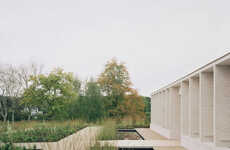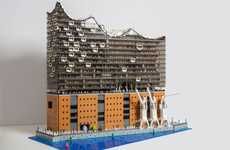
The Nossa Senhora de Fatima Chapel Sits Atop a Plateau
Joey Haar — January 24, 2018 — Art & Design
References: archdaily
The grandiosity and ornateness of religious buildings paved the way for architecture as a practice, but the Nossa Senora de Fatima chapel in Portugal shows that not all edifices built with religion in mind need to be grand. The small outdoor chapel is simple and modern, standing in opposition to the titans of the Gothic Revival while positing an even more impressive alternative.
Though nominally a chapel, Nossa Senhora de Fatima doesn't look like a typical religious structure. That's because the building itself is little more than an angular canopy, making it an outdoor chapel. The implication for the building is that those in attendance should look out at nature rather than in at artificial things. Considering that much of religious architecture is grounded in the idea of creating something as glorious as God, the decision to defer to nature is a clever one.
Though nominally a chapel, Nossa Senhora de Fatima doesn't look like a typical religious structure. That's because the building itself is little more than an angular canopy, making it an outdoor chapel. The implication for the building is that those in attendance should look out at nature rather than in at artificial things. Considering that much of religious architecture is grounded in the idea of creating something as glorious as God, the decision to defer to nature is a clever one.
Trend Themes
1. Simple Outdoor Chapels - The rise of minimalistic, nature-centered outdoor chapels that deviate from traditional grandiosity presents an opportunity for architects and designers to create innovative and serene religious spaces.
2. Modern Religious Architecture - The emergence of modern, angular designs in religious structures challenges the conventions of traditional religious architecture and opens up avenues for inventive and contemporary approaches in the industry.
3. Nature-centric Spaces - The trend of creating chapels that prioritize connecting with nature over opulence creates a disruptive opportunity for the tourism industry to cater to eco-conscious travelers seeking spiritual and natural experiences.
Industry Implications
1. Architecture - Architects can explore the design possibilities of simple outdoor chapels and modern religious architecture to create innovative and minimalist spaces for worship and reflection.
2. Design - The trend towards modern religious architecture presents a market opportunity for designers to create unique and aesthetically pleasing religious structures that deviate from traditional norms.
3. Tourism - The rise of nature-centric outdoor chapels offers the tourism industry a chance to cater to a growing market of travelers seeking eco-friendly and spiritually fulfilling experiences in serene natural settings.
1.2
Score
Popularity
Activity
Freshness























